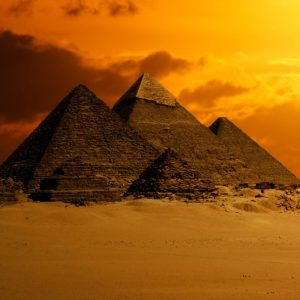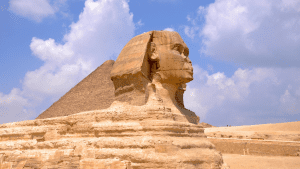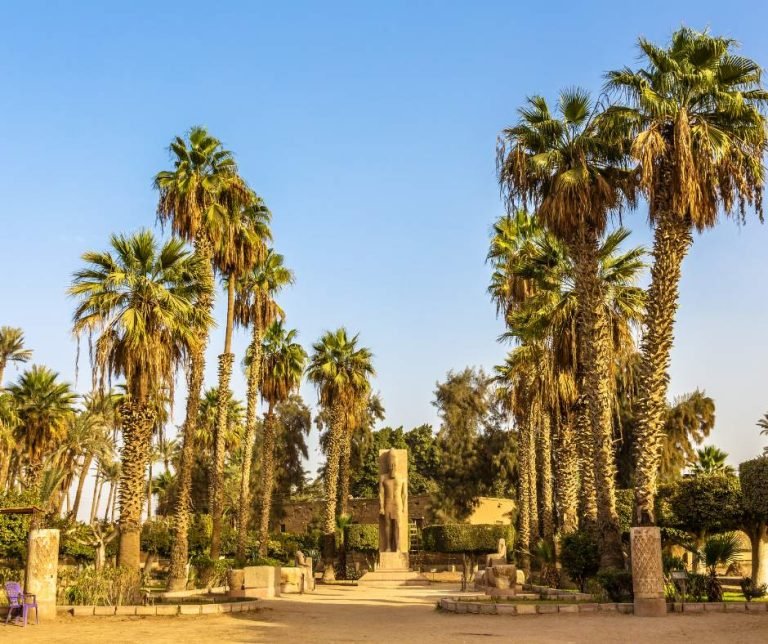
Home » Weekly Blog » The Rise and Fall of Ancient Memphis: Egypt’s First Capital
The Rise and Fall of Ancient Memphis: Egypt’s First Capital
Table of Contents
Imagine a city that once echoed with the footsteps of pharaohs, where the gods were believed to have whispered the secrets of the cosmos into the ears of the chosen few. A place where grand temples stood tall against the sky, and the scent of incense wafted through bustling markets filled with traders from every corner of the known world. This was Memphis—the first capital of ancient Egypt and a cornerstone of a civilization that would shape human history.
Long before the grandeur of Thebes or the splendor of Alexandria, Memphis was the heart of Egypt, both politically and spiritually. Founded at the dawn of the Egyptian state, it was here that the first kings of a united Egypt forged their empire, and it was here that the divine and the mortal intertwined in ways that defined the very essence of what it meant to be Egyptian.
But like all great cities, Memphis’s story is one of both ascent and decline. Once the cradle of power, it eventually became a relic of a bygone era, overshadowed by the rise of new cities and empires. Today, only fragments remain—a few scattered ruins, a colossal statue here, a crumbling temple there—yet its legacy continues to captivate and inspire.
Join us as we journey back in time to explore the rise and fall of ancient Memphis, Egypt’s first capital. We’ll uncover its origins, bask in its golden age, and delve into the forces that led to its decline, all while revealing the profound impact this city had on the ancient world.
The Origins of Memphis
Geographical Location
Memphis’s rise to prominence was no accident. Its strategic location at the juncture of Upper and Lower Egypt made it the perfect place for a capital. Situated just south of the Nile Delta, Memphis commanded the fertile floodplains, ensuring a stable food supply and control over key trade routes. The city lay at the point where the Nile begins to fan out, making it a natural crossroads for goods, people, and ideas traveling between the Mediterranean and the African interior.
This position not only gave Memphis access to the wealth of the Nile but also placed it in the heart of the ancient world’s most dynamic region. Control over Memphis meant control over Egypt itself, and whoever held this city held the keys to a vast and powerful kingdom.
Foundation Legend
Every great city has its founding myth, and Memphis is no exception. According to tradition, it was King Menes—also known as Narmer—who established Memphis as the capital of a newly unified Egypt around 3100 BCE. Legend has it that Menes diverted the course of the Nile to create the city’s site, symbolically binding the two lands of Upper and Lower Egypt in a single, powerful stroke. This act of engineering prowess not only demonstrated the king’s power over nature but also established the city’s divine favor from the very beginning.
The city’s original name, “Ineb-Hedj,” which means “The White Walls,” referred to the imposing fortifications that surrounded it. These walls were not just defensive structures; they were a symbol of the king’s authority and the strength of the unified state. Over time, the city came to be known as Memphis, after the nearby pyramid complex of Men-nefer, which later Greeks would adapt into “Memphis.”
The White Walls of Memphis
The “White Walls” of Memphis were more than just a physical barrier; they were a statement of power. Constructed from gleaming white limestone, they reflected the brilliance of the sun, serving as a constant reminder of the city’s status as the heart of the Egyptian state. Inside these walls, the pharaohs built palaces, administrative centers, and temples dedicated to the gods who protected their rule.
These walls also played a crucial role in the city’s mythology. They were said to be the place where the gods Ptah and Sekhmet resided, watching over the pharaoh and his people. The walls of Memphis were not just a symbol of earthly power but a divine fortress, protecting the sacred order that held the cosmos together.

Memphis: The Political and Religious Capital
Role as the Capital of United Egypt
As the first capital of a united Egypt, Memphis was the stage upon which the earliest pharaohs enacted their divine right to rule. It was here that the pharaohs consolidated their power, overseeing the administration of a vast and diverse kingdom. From Memphis, the kings of the Old Kingdom (2686–2181 BCE) launched expeditions to expand their borders, sent emissaries to distant lands, and coordinated the construction of the pyramids—the most iconic symbols of their reign.
Memphis was more than just a political center; it was the heart of the state’s bureaucracy. Scribes, officials, and priests all worked within its walls, recording the deeds of the pharaohs and the bounty of the Nile. The city was a hive of activity, with caravans arriving from the deserts, ships docking on the riverbanks, and craftsmen laboring in workshops to produce the goods that would fill the temples and palaces.
Religious Importance
The religious significance of Memphis was profound. It was here that the god Ptah, the creator of the universe, was said to reside. Ptah was not just a local deity; he was a cosmic architect, a god who spoke the world into being. His great temple, Hut-ka-Ptah, was one of the most important religious sites in Egypt, attracting pilgrims from across the land.
The priests of Ptah were not just spiritual leaders; they were scholars and craftsmen, responsible for preserving the knowledge and skills that underpinned Egyptian civilization. The temple was a center of learning, where mathematics, medicine, and architecture were studied and refined. It was also a place of artistic innovation, where sculptors and painters created works that would define the aesthetic of ancient Egypt for millennia.
Memphis’s role as a religious center was further enhanced by its association with other deities. The city was linked to the god Sokar, a protector of the dead, and was believed to be the site where the creator god Atum first emerged from the primeval waters. These connections made Memphis a place of profound spiritual significance, a city where the divine was never far from the minds of its inhabitants.
The Construction of the Pyramids
One cannot speak of Memphis without mentioning its role in the construction of the pyramids. The city’s location near the Giza Plateau made it the ideal base for the massive workforce required to build these monumental structures. From Memphis, architects, engineers, and laborers were organized into teams, each responsible for a different aspect of the construction process.
The pyramids themselves were not just tombs; they were statements of the pharaoh’s power and divine status. Their construction required an unprecedented level of planning and coordination, with resources being brought in from across Egypt and beyond. The quarries at Tura provided the fine limestone for the outer casing, while the granite used in the inner chambers was transported all the way from Aswan, over 800 kilometers to the south.
The construction of the pyramids also had a profound impact on Memphis itself. The city’s population swelled as workers and their families settled in the area, creating a thriving community that supported the building projects. Workshops and factories sprang up to supply the tools and materials needed for construction, while food and water had to be brought in to sustain the vast workforce.
The pyramids were not just monuments to the dead; they were a testament to the organizational prowess of the living. Their construction cemented Memphis’s status as the political and cultural heart of Egypt, a city where the impossible became reality.
Economic Power and Influence
Trade Routes and Economic Hub
Memphis’s strategic position made it a natural center for trade, both within Egypt and beyond. The city’s proximity to the Nile Delta meant that it was ideally placed to control the flow of goods between Upper and Lower Egypt. But its influence extended far beyond the borders of the kingdom. From Memphis, merchants set out on expeditions to the lands of Nubia, Punt, and the Levant, bringing back exotic goods that enriched the city and its people.
The markets of Memphis were legendary, filled with goods from across the known world. Spices from Arabia, gold from Nubia, and cedar wood from Lebanon all passed through the city’s bustling bazaars. Traders from distant lands could be seen bartering with local merchants, their ships moored along the banks of the Nile, laden with treasures from across the seas.
This flow of goods made Memphis one of the wealthiest cities of the ancient world. The wealth of the Nile was concentrated here, fueling the construction of grand temples and palaces. The city’s prosperity attracted not just merchants but also craftsmen and artists, who came to work in its workshops and temples, creating the objects that would fill the tombs of kings and nobles.
Cultural Influence
The economic power of Memphis was matched by its cultural influence. As a hub of trade and administration, the city was a melting pot of people and ideas. It was here that the distinct culture of ancient Egypt began to take shape, blending elements from both Upper and Lower Egypt into a unified whole.
Memphis was a center of learning, where scribes and priests studied the mysteries of the universe and recorded the deeds of kings. It was a place where art and architecture flourished, as craftsmen and builders experimented with new forms and techniques. The influence of Memphis can be seen in the grand monuments that dot the Nile Valley, from the pyramids of Giza to the temples of Luxor.
The city’s cultural influence extended beyond Egypt’s borders. The fame of Memphis reached distant lands, and its art and architecture were imitated by neighboring cultures. The city’s temples and palaces served as models for the great buildings of the ancient world, while its religious ideas influenced the beliefs of peoples as far afield as Mesopotamia and Greece.
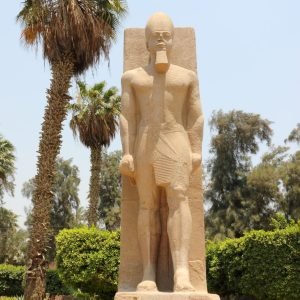
The Decline of Memphis
Shifting Political Centers
The decline of Memphis was not sudden but a gradual process that unfolded over centuries. The city’s fortunes began to wane during the Middle Kingdom (2055–1650 BCE), as the political center of Egypt shifted southward to Thebes. This shift was driven by a combination of factors, including the rise of powerful Theban dynasties and the need to defend Egypt’s southern borders against the growing threat of Nubian expansion.
As Thebes grew in power, Memphis’s role as the capital diminished. The city remained an important administrative and religious center, but it was no longer the heart of the kingdom. The pharaohs of the Middle and New Kingdoms (1550–1069 BCE) chose to build their great temples and tombs in the Theban region, and Memphis gradually lost its preeminence.
Foreign Invasions
The decline of Memphis was further accelerated by a series of foreign invasions that shook Egypt to its core. In the 17th century BCE, the Hyksos, a people of uncertain origin, invaded Egypt and established their own dynasty, ruling from the city of Avaris in the Nile Delta. Although the Hyksos were eventually expelled, their occupation weakened Memphis and disrupted the traditional order.
Later, in the 7th century BCE, the Assyrians invaded Egypt, capturing Memphis and sacking its temples. This invasion marked the beginning of a turbulent period in Egyptian history, as the country was repeatedly invaded and occupied by foreign powers, including the Persians, who made Memphis their administrative capital during their rule.
Memphis in the Late Period
Despite these challenges, Memphis remained a significant city throughout the Late Period (664–332 BCE). The Saite dynasty, which ruled from Sais in the Delta, made efforts to restore the city’s former glory. They rebuilt temples and revitalized the economy, and Memphis once again became a center of political and religious life.
However, the city never regained its former status. The rise of Alexandria, founded by Alexander the Great in 331 BCE, marked the final blow to Memphis’s prominence. As Alexandria grew into a major center of trade, learning, and culture, Memphis faded into the background, its glory days a distant memory.
The Final Fall and Legacy of Memphis
Memphis under Greek and Roman Rule
By the time of the Greek and Roman periods, Memphis was a shadow of its former self. Although it continued to be occupied and its temples remained active, the city had been eclipsed by Alexandria, which had become the new capital and cultural hub of Egypt.
Under the Ptolemies and later the Romans, Memphis was still respected as a religious center, particularly the temple of Ptah, which remained a place of pilgrimage. But the city was no longer the vibrant metropolis it had once been. Its population dwindled, and many of its grand buildings fell into disrepair.
Archaeological Rediscovery
The final chapter of Memphis’s story began in the 19th century, when European explorers and archaeologists rediscovered the city’s ruins. What they found was a landscape of broken statues, collapsed walls, and sand-covered temples. But even in its ruined state, Memphis revealed the grandeur of its past.
Excavations have uncovered the remains of the great temple of Ptah, colossal statues of Ramesses II, and the remnants of palaces and workshops. These discoveries have helped to piece together the history of a city that was once the heart of the world’s greatest civilization.
Legacy
The legacy of Memphis is vast and enduring. As the first capital of a united Egypt, it set the stage for the development of the pharaonic state and the culture that we now associate with ancient Egypt. Its art, architecture, and religious traditions influenced the entire Mediterranean world and continue to fascinate and inspire people today.
The story of Memphis is a reminder of the impermanence of human achievements. Even the mightiest cities can fall, their glory fading into the sands of time. But as long as we remember and learn from them, their legacy endures.
Conclusion
Memphis was more than just a city; it was the embodiment of a civilization. It was here that the first kings of a united Egypt ruled, and it was here that the foundations of Egyptian culture and statecraft were laid. From its origins as the White Walls of Menes to its decline in the shadow of Alexandria, the story of Memphis is the story of ancient Egypt itself.
Today, the ruins of Memphis may be quiet, but they still speak. They tell of a time when the city was the heart of a great civilization, a place where gods and kings walked the earth together. By exploring the rise and fall of Memphis, we gain a deeper understanding of the forces that shaped the ancient world and a greater appreciation for the achievements of those who came before us.
So, the next time you think of ancient Egypt, remember Memphis—the city that started it all. And if you ever find yourself wandering among its ruins, take a moment to listen. You might just hear the echoes of history.
Share this with your friends
Additional Blog Posts

How to Avoid Scams in Egypt: The Luxury Traveler’s Guide
Egypt’s wonders draw millions, but so do the scammers waiting to exploit them. From taxi tricks to counterfeit tickets, the risks are real—and costly. This guide pulls back the curtain on Egypt travel scams and shows how choosing a trusted luxury operator like Ancient Navigator can turn risk into reward.

Luxury Egypt Packing List: What to Bring (and What to Skip)
Think Egypt is all sand and camels? Think again. This isn’t your average packing list—it’s your blueprint for showing up in style, comfort, and cultural confidence. From rooftop dinners in Cairo to Nile cruises at sunset, we reveal exactly what luxury travelers need (and what to leave behind). Pack smart. Travel stunning.

Planning a Trip to Egypt? Here’s How Long You Need
Think you can “do” Egypt in 3 days? Think again. From ancient tombs to Nile-side secrets, this guide reveals why the magic of Egypt demands more than a layover—and shows you exactly how many days you really need to make it unforgettable. Don’t book that flight until you read this.

How Far Does $100 Go in Egypt?
Think $100 won’t get you far? In Egypt, it’s a game-changer. From luxury hotels to mouthwatering meals and ancient wonders, see how far your dollar really goes. This guide breaks down real costs, insider tips, and jaw-dropping experiences you can afford—without breaking the bank.
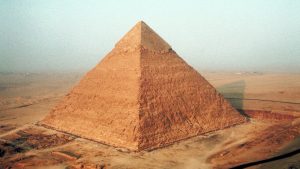
Private Egyptologist Tours: Unlock Egypt’s Hidden Secrets in Luxury
Step beyond the velvet ropes of Egypt’s most iconic sites. With a private Egyptologist as your guide, you’ll uncover hidden chambers, untold stories, and experience ancient wonders far from the tourist crowds. This is discovery at its most exclusive—where history meets luxury.
Past Blog Posts

Luxury Egypt Packing List: What to Bring (and What to Skip)
Think Egypt is all sand and camels? Think again. This isn’t your average packing list—it’s your blueprint for showing up in style, comfort, and cultural confidence. From rooftop dinners in Cairo to Nile cruises at sunset, we reveal exactly what luxury travelers need (and what to leave behind). Pack smart. Travel stunning.

Planning a Trip to Egypt? Here’s How Long You Need
Think you can “do” Egypt in 3 days? Think again. From ancient tombs to Nile-side secrets, this guide reveals why the magic of Egypt demands more than a layover—and shows you exactly how many days you really need to make it unforgettable. Don’t book that flight until you read this.

How Far Does $100 Go in Egypt?
Think $100 won’t get you far? In Egypt, it’s a game-changer. From luxury hotels to mouthwatering meals and ancient wonders, see how far your dollar really goes. This guide breaks down real costs, insider tips, and jaw-dropping experiences you can afford—without breaking the bank.



